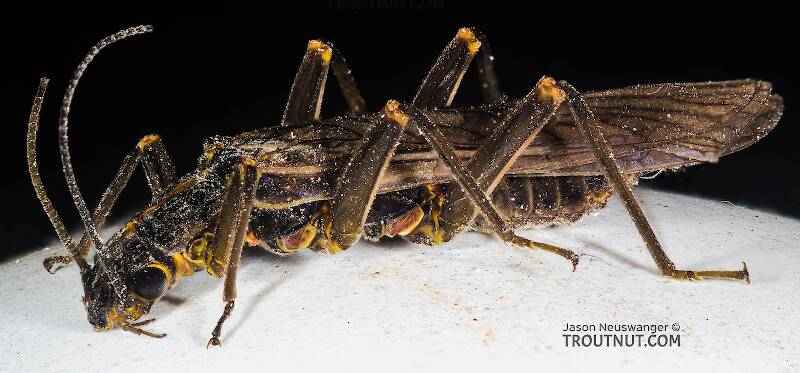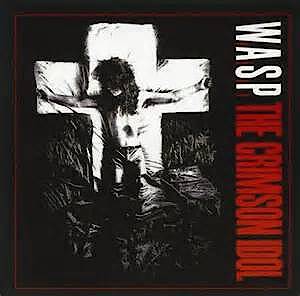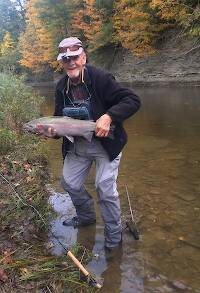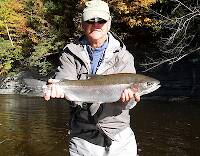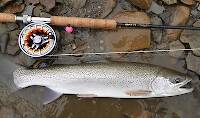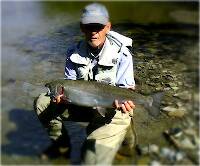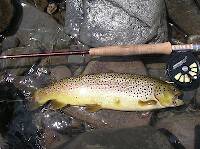
Blue-winged Olives
Baetis
Tiny Baetis mayflies are perhaps the most commonly encountered and imitated by anglers on all American trout streams due to their great abundance, widespread distribution, and trout-friendly emergence habits.
Featured on the forum

Troutnut is a project started in 2003 by salmonid ecologist Jason "Troutnut" Neuswanger to help anglers and
fly tyers unabashedly embrace the entomological side of the sport. Learn more about Troutnut or
support the project for an enhanced experience here.
PaulRoberts on Feb 24, 2012February 24th, 2012, 9:49 am EST
With crayfish it can take a couple days for them to harden. When we used to buy softshells to catch smallmouths with, they remained soft for that long. From what I've read, crayfish can harden in a matter of hours in calcium rich waters, "instead of days". Crayfish also had a tendency to eat one another when in the soft stage; It wasn't only the smallmouths that relished them.
As to stoneflies, I have no idea how long it takes or how available they might be; I've never taken one from a trout stomach, that I remember, or recognized. Stoneflies molt up to 2 dozen times over their 1 to 3 year life cycles. That's about once a month, and at least in crayfish there tends to be some level of syncronicity in molting. Like crayfish, lobsters, and crabs, stoneflies are pretty much secluded beneath substrate during -for good reason. Whether that reason might result in something recognizable to trout is an open question. Whether it's a "secret" or not is in the mind of the beholder. I don't publish my "secrets" (cause I don't have any -but don't tell anyone :) ).
One thing I've liked about the yarns is the ability to create contrasting colors -esp pale bellies on nymphs.
Thanks for the compliments, guys.
As to stoneflies, I have no idea how long it takes or how available they might be; I've never taken one from a trout stomach, that I remember, or recognized. Stoneflies molt up to 2 dozen times over their 1 to 3 year life cycles. That's about once a month, and at least in crayfish there tends to be some level of syncronicity in molting. Like crayfish, lobsters, and crabs, stoneflies are pretty much secluded beneath substrate during -for good reason. Whether that reason might result in something recognizable to trout is an open question. Whether it's a "secret" or not is in the mind of the beholder. I don't publish my "secrets" (cause I don't have any -but don't tell anyone :) ).
One thing I've liked about the yarns is the ability to create contrasting colors -esp pale bellies on nymphs.
Thanks for the compliments, guys.
Entoman on Feb 24, 2012February 24th, 2012, 6:06 pm EST
Paul -
That's a brilliant fly design by the way! Excellent use of affordable materials and I assume a fairly straight forward tie once you get it down (important for snag prone stones). For my taste, it also has the right mix of realism and impressionism. I assume you also tie this pattern in standard colors as well?
I remember seining for critters a long time ago and took a good sample of golden stones where one of them was an "albino." Elated with my find, I segregated it out in the cooler for the drive home. Anyway, by the time I got home the critter had darkened considerably, much to my disappointment. This was long before I had any idea they lightened so much when molting. Of course, this is pretty anecdotal and I have no idea if it is common for this to happen so quickly, nor do I have any idea as to when the molt actually took place. But it's still a lesson I haven't forgotten.
Me either. Though like you, I haven't killed many fish since I've known about pale molts anyway, so I don't know how indicative this fact is. Gullet pumping doesn't seem to work so well on critters this big.:)
I seem to remember angling reports of stonefly molt synchronicity during at least the last one, and this involved the years hatch in the early Spring. I'm struggling a bit though to find evidence of this in the scientific Lit. Some anglers swear by fishing molts in the early hours after daylight until they darken up, supposedly by midday. This is usually well before the hatch that occurs later in the season. I have never experienced this phenomena, nor have I ever seined a specimen from the drift. The few I've found were safely sheltered in the rocks and I had to kick 'em out.:) They are pretty rare to find in my experience, and I've sampled Golden Stone habitat many, many times in JA, FE & MA when this supposedly occurs.
That's a brilliant fly design by the way! Excellent use of affordable materials and I assume a fairly straight forward tie once you get it down (important for snag prone stones). For my taste, it also has the right mix of realism and impressionism. I assume you also tie this pattern in standard colors as well?
As to stoneflies, I have no idea how long it takes or how available they might be;
I remember seining for critters a long time ago and took a good sample of golden stones where one of them was an "albino." Elated with my find, I segregated it out in the cooler for the drive home. Anyway, by the time I got home the critter had darkened considerably, much to my disappointment. This was long before I had any idea they lightened so much when molting. Of course, this is pretty anecdotal and I have no idea if it is common for this to happen so quickly, nor do I have any idea as to when the molt actually took place. But it's still a lesson I haven't forgotten.
I've never taken one from a trout stomach, that I remember, or recognized.
Me either. Though like you, I haven't killed many fish since I've known about pale molts anyway, so I don't know how indicative this fact is. Gullet pumping doesn't seem to work so well on critters this big.:)
and at least in crayfish there tends to be some level of syncronicity in molting.
I seem to remember angling reports of stonefly molt synchronicity during at least the last one, and this involved the years hatch in the early Spring. I'm struggling a bit though to find evidence of this in the scientific Lit. Some anglers swear by fishing molts in the early hours after daylight until they darken up, supposedly by midday. This is usually well before the hatch that occurs later in the season. I have never experienced this phenomena, nor have I ever seined a specimen from the drift. The few I've found were safely sheltered in the rocks and I had to kick 'em out.:) They are pretty rare to find in my experience, and I've sampled Golden Stone habitat many, many times in JA, FE & MA when this supposedly occurs.
"It's not that I find fishing so important, it's just that I find all other endeavors of Man equally unimportant... And not nearly as much fun!" Robert Traver, Anatomy of a Fisherman
PaulRoberts on Feb 25, 2012February 25th, 2012, 3:38 am EST
Thanks, Kurt. Interesting –I’ve never kept one to see. I have not found a lot of them either (although I’m not surprised when I do), and they've been deep under substrate too. You are likely right that the math, at a glance, isn’t there to support white nymphs being a regular food item.
As to molting synchronicity in crayfish, I did find this piece:
http://www.hort.purdue.edu/newcrop/proceedings1993/v2-654.html
For the record, considering the way this thread is leaning –that this may be some “revealed secret” – I want to reiterate:
Whether it’s better than any other attractor is really a subjective call. Visibility helps but the amount of that may matter. I’m very confident with this fly during periods of discolored water (not all that uncommon in the disturbed watersheds I frequented back East). Trout seem to be able to find it very well. If I hadn’t already rolled up a few a while back, I’d likely do just as well with a more normal colored golden-backed one, and have one less tying chore.
But who knows… Despite the math, maybe Bryan Farmer is onto something. He’s not the only one to try to make a ta-do about “white nymphs”:
http://www.sparsegreymatter.com/viewtopic.php?f=17&t=3359
…
http://forums.catskillflies.com/index.php/topic/805-stoneflies/
I myself read something a while back in older European angling lit that white was an especially good color for brown trout. I passed it off as likely more to do with visibility in certain habitats, than something, say, instinctive regarding molting insects.
Secret trout killer? Or … just another attractor? I’ve always leaned toward the latter. But I wouldn’t be surprised either to find out that trout have developed some instinctive response to the vulnerability of shedding arthropods.
Well…what’s cabin fever for, eh?
As to molting synchronicity in crayfish, I did find this piece:
http://www.hort.purdue.edu/newcrop/proceedings1993/v2-654.html
Brown, P.B. 1993. Soft-shell crayfish: A new crop for the Midwest. p. 654-656. In: J. Janick and J.E. Simon (eds.), New crops. Wiley, New York.
…
Regardless of temperature, there was a biphasic response of molting activity. That response became more dramatic as temperature increased from 20° to 30deg.C. In general, a large number of crayfish molted within the first 5 to 10 days (as many as 64% of the population reared at 30°C), followed by a quiescent period, then another period of molting. This observation has important management implications. …
Native midwestern crayfish will molt in controlled situations and that molting is influenced by water temperature. Molting activity is relatively rapid, with a large percentage occurring within the first 10 days. The response, regardless of temperature, was biphasic and probably reflects individuals in different stages of the molt cycle when acquired. Those that were near stage E (ecdysis) in the molt cycle molted within the first 5 to 10 days, while those is earlier stages required approximately 15 days to molt. Management options are now available to aquaculturists that will allow more carefully manipulated molting activity patterns in populations of native midwestern crayfish. …
For the record, considering the way this thread is leaning –that this may be some “revealed secret” – I want to reiterate:
As Falsifly says, I doubt many fish would pass on ANY nymph; At least in most streams where trout cannot afford to be too choosy. And, if the insects are anything like crayfish, they'd be hunkered down and well concealed when molting.
I've done particularly well on this fly when creeks are roiled following rains. It's a go-to then and I think it's particularly visible in those conditions, and that may be all there is to it. Why not...chartreuse? Aesthetics I guess. I like to THINK I'm matching something in nature, when again, visibility may be all there is to it. But, I'll pitch chartreuse to any lake-run fish without qualm. Weird animals we are.
Whether it’s better than any other attractor is really a subjective call. Visibility helps but the amount of that may matter. I’m very confident with this fly during periods of discolored water (not all that uncommon in the disturbed watersheds I frequented back East). Trout seem to be able to find it very well. If I hadn’t already rolled up a few a while back, I’d likely do just as well with a more normal colored golden-backed one, and have one less tying chore.
But who knows… Despite the math, maybe Bryan Farmer is onto something. He’s not the only one to try to make a ta-do about “white nymphs”:
http://www.sparsegreymatter.com/viewtopic.php?f=17&t=3359
Picked up a copy of 'Stoneflies for the Angler,' by Eric Leiser and Bob Boyle, published in 1982.
I haven't seen many angling books on stoneflies, and this one is pretty informative.
One of the chapters is entitled, 'The secret of the white nymph.' The authors describe how when some (many?) nymphs molt, they turn white for a few hours while their shell hardens and darkens.
The white nymphs don't move around much in that state, but if they get washed downstream, it sounds like trout hammer them.
…
http://forums.catskillflies.com/index.php/topic/805-stoneflies/
…
Swisher & Richards have to say about it in "Emergers" (c. 1991, p.69) :
"Each time [stonefly nymphs] undergo this "shedding" their color changes to a much lighter shade. Most species, except the very dark genera, become almost pure white.
"At these times, that trout are particularly susceptible to an imitation tied in the Curled Stone pattern, only very light in color. The tails, body, hackle, wing pads, and antennae are very light cream and the ribbing is light yellow. We call the pattern the Albino Stone. Trout prefer this pattern if they can get it, much as a smallmouth bass prefers soft-shelled crayfish over hard-shelled crayfish...."
They then go on to describe their "soft and resilient" pattern:
…
If you look on page 116 of "The Orvis FLy Pattern Index, Complete and Unabridged" by John R. Harder (c 1978, 1990), you find the following recipe for the Shedding Stone Fly
…
I myself read something a while back in older European angling lit that white was an especially good color for brown trout. I passed it off as likely more to do with visibility in certain habitats, than something, say, instinctive regarding molting insects.
Secret trout killer? Or … just another attractor? I’ve always leaned toward the latter. But I wouldn’t be surprised either to find out that trout have developed some instinctive response to the vulnerability of shedding arthropods.
Well…what’s cabin fever for, eh?
Martinlf on Feb 27, 2012February 27th, 2012, 9:44 am EST
This fly (and other nymphs) are tied by dubbing the body, overlayed with a strip of a contrasting color. The head is formed in "bullet head" fashion.
OK, Paul, when you get tired of my trying to pry all your secrets out of you, just let me know. :) Till then you can expect this kind of question:
Do you chop the yarn to dub the body then overlay a strand of unravelled yarn? I'm thinking chop up some white, dub the body, then use something such as eggshell for the overlay.
And the next question--do you use this method and material for mayflies also?
"He spread them a yard and a half. 'And every one that got away is this big.'"
--Fred Chappell
--Fred Chappell
PaulRoberts on Feb 27, 2012February 27th, 2012, 11:19 am EST
I cut a ~1" to 1-1/2" piece and just pull fibers out to dub, either spun onto the thread or in a loop. The "overlay" is just a length of one strand of yarn.
I rarely use white, as it's too bright -using it mostly for minnow bellies. I use the color "Fleshtone" for many nymph bellies, and for the molting stone back overlay too. LOTS can be done with yarns -esp such a translucent one. I use it for mayflies too:


I rarely use white, as it's too bright -using it mostly for minnow bellies. I use the color "Fleshtone" for many nymph bellies, and for the molting stone back overlay too. LOTS can be done with yarns -esp such a translucent one. I use it for mayflies too:


Entoman on Feb 27, 2012February 27th, 2012, 11:55 am EST
Very nice ephemerid and heptageniid nymphs, Paul. Man, I'd sure fish those with confidence! It looks like you are using a 200R hook on the ephemerid. What did you incorporate into the design to help it stay upright? This hook gives me fits.:)
"It's not that I find fishing so important, it's just that I find all other endeavors of Man equally unimportant... And not nearly as much fun!" Robert Traver, Anatomy of a Fisherman
PaulRoberts on Feb 27, 2012February 27th, 2012, 12:36 pm EST
Yes, it's the Mustad version (80050 I think). I've not had the "leggo" problems you guys were talking about, although I haven't used them much.
This fly is stabilized, and I admit weakly, with the long tail on the long shank started up the shank a bit, and the gills and legs being above the shank. The straight eye doesn't offer much help though. This, the bendy wire, and small gap, may affect holding power too?
I tied this fly for the E invaria emergences I found on some CNY streams. I was excited about the potential of these Ephemera's for big lower mid-reach browns on those waters, but it never panned out. Or at least I never got into a such a situation as they emerged in that marginal trout habitat about the time it began to heat up. Could be done though at the right time and place. I'd started with dries but the duns seemed to get off the water very quickly. So I switched to nymphs for more drift time.
This fly is stabilized, and I admit weakly, with the long tail on the long shank started up the shank a bit, and the gills and legs being above the shank. The straight eye doesn't offer much help though. This, the bendy wire, and small gap, may affect holding power too?
I tied this fly for the E invaria emergences I found on some CNY streams. I was excited about the potential of these Ephemera's for big lower mid-reach browns on those waters, but it never panned out. Or at least I never got into a such a situation as they emerged in that marginal trout habitat about the time it began to heat up. Could be done though at the right time and place. I'd started with dries but the duns seemed to get off the water very quickly. So I switched to nymphs for more drift time.
PaulRoberts on Mar 9, 2012March 9th, 2012, 7:58 am EST
Here's another one, I caught yesterday. A Baetis this time. Quite a few were pale but not this light. They appeared to be coming out of their final molt as their emergence is imminent here:

Oh...I also saw this piebald robin along the stream. It looked like a flying cottonball! I've seen the odd white tail feather, but this mutant was new to me:


Oh...I also saw this piebald robin along the stream. It looked like a flying cottonball! I've seen the odd white tail feather, but this mutant was new to me:

Entoman on Mar 9, 2012March 9th, 2012, 9:09 am EST
As you mentioned in the other thread, hawk food? :) The blonde baetid makes you wonder... They would be much more available to the trout than stoneflies if there is any synchronicity to this. Did you find a bunch of them, or just the odd one from time to time?
"It's not that I find fishing so important, it's just that I find all other endeavors of Man equally unimportant... And not nearly as much fun!" Robert Traver, Anatomy of a Fisherman
PaulRoberts on Mar 9, 2012March 9th, 2012, 9:31 am EST
Yeah, it''s a wonder that bird is alive. Now if it were a starling, an open country bird that depends on blending into its flock ... that's likely an even more intense story.
As to the Baetis...Can't answer that. I've always noted variation in Baetids of like size from quite pale ones to really dark ones. I assume the dark ones are ready to pop, the pale ones not quite yet. Yesterday I noticed none that were very dark or with black wing buds yet -but it's getting really close now. The photo is the only truly "white" nymph I saw. Yesterday the action was midges, with browns rising to them in 42F water.
The majority of Baetis in the stream have pale bellies, even those close to popping, with the rest being pretty pale on the sides too. So...it makes sense a Baetis nymph (and many others) should be pale. Just because the dry versions have been called "Olives" forever doesn't mean the nymphs always, even often, are.
As to the Baetis...Can't answer that. I've always noted variation in Baetids of like size from quite pale ones to really dark ones. I assume the dark ones are ready to pop, the pale ones not quite yet. Yesterday I noticed none that were very dark or with black wing buds yet -but it's getting really close now. The photo is the only truly "white" nymph I saw. Yesterday the action was midges, with browns rising to them in 42F water.
The majority of Baetis in the stream have pale bellies, even those close to popping, with the rest being pretty pale on the sides too. So...it makes sense a Baetis nymph (and many others) should be pale. Just because the dry versions have been called "Olives" forever doesn't mean the nymphs always, even often, are.
Falsifly on Mar 9, 2012March 9th, 2012, 9:57 am EST
The photo is the only truly "white" nymph I saw. Yesterday the action was midges, with browns rising to them in 42F water.
Paul, did you pass on the midge fishing in pursuit of something easier to catch? :)
Falsifly
When asked what I just caught that monster on I showed him. He put on his magnifiers and said, "I can't believe they can see that."
When asked what I just caught that monster on I showed him. He put on his magnifiers and said, "I can't believe they can see that."
Martinlf on Mar 10, 2012March 10th, 2012, 7:23 am EST
I've taken to ribbing some of my baetids with thin chartreuse thread ribs, working on the Kreh maxim, "If it ain't chartreuse, it ain't no use." The fish seem to approve, though it's clear to me that unribbed, or white ribbed flies might have worked just as well. But, if Caucci and Nastasi were right about spectumized colors, or if the UV crowd is on to anything, the extra time may be worth it. Now there's a study I'd like to see done, but doubt statistically significant analyses will be forthcoming any time soon.
"He spread them a yard and a half. 'And every one that got away is this big.'"
--Fred Chappell
--Fred Chappell
Entoman on Mar 10, 2012March 10th, 2012, 10:44 am EST
I've taken to ribbing some of my baetids with thin chartreuse thread ribs
Interesting idea, Louis. I know that chartreuse ribbing on some caddis pupa can sometimes make a dramatic difference but never thought about using it on baetids (except for tiny anoka). I'll have to give it a try this season.
"It's not that I find fishing so important, it's just that I find all other endeavors of Man equally unimportant... And not nearly as much fun!" Robert Traver, Anatomy of a Fisherman
PaulRoberts on Mar 10, 2012March 10th, 2012, 1:16 pm EST
The photo is the only truly "white" nymph I saw. Yesterday the action was midges, with browns rising to them in 42F water.
Paul, did you pass on the midge fishing in pursuit of something easier to catch? :)
Well, that's why I like this site. I can show off my catches and not even bring a rod to the stream.
I actually did fish, but took those midging browns on hassle free 5X and a #16 parachute.
Wiflyfisher on Apr 14, 2012April 14th, 2012, 4:30 am EDT
Seriously, pale or white? If during the many instar molts the only exuviae is the exocuticle I’m left wondering just how much of a nymph’s color is expressed in the exocuticle. Besides that I doubt that sans the exocuticle the nymph would appear white.
I found this guy hiding under a rock the other day.

http://flypatternsfortrout.com/2012/04/14/are-mayfly-nymphs-white-between-instar-stages/
John S.
https://WiFlyFisher.com
https://WiFlyFisher.com
PaulRoberts on Apr 14, 2012April 14th, 2012, 5:12 am EDT
Neat. Very pretty Heptageniid -Maccaffertium?
Wiflyfisher on Apr 14, 2012April 14th, 2012, 6:58 am EDT
Neat. Very pretty Heptageniid -Maccaffertium?
Not sure. My guess is Light Cahill (Stenonema or Stenocron) because it is smaller in size.
John S.
https://WiFlyFisher.com
https://WiFlyFisher.com
Adirman on Apr 14, 2012April 14th, 2012, 10:26 am EDT
This same nymph came up on another FFing forum I belong to and the guys there thought it might be a Light Cahill due to the size. Someone else said March Brown though. Anyone know for sure?
Entoman on Apr 14, 2012April 14th, 2012, 10:59 am EDT
It's hard to rule out many heptageniids with what's visible in the photo. This is an early instar that's recently molted. Since one would think that March Browns would be a little further along at this time, I agree with John that one of the plethora of Cahills is most likely.
Nice photo, John.
Nice photo, John.
"It's not that I find fishing so important, it's just that I find all other endeavors of Man equally unimportant... And not nearly as much fun!" Robert Traver, Anatomy of a Fisherman
Wiflyfisher on Apr 14, 2012April 14th, 2012, 12:38 pm EDT
This same nymph came up on another FFing forum I belong to and the guys there thought it might be a Light Cahill due to the size. Someone else said March Brown though. Anyone know for sure?
Are you referring to the Sparse Grey Matter forum where I posted it to confirm what CJ had mentioned?
John S.
https://WiFlyFisher.com
https://WiFlyFisher.com
Quick Reply
Related Discussions
Topic
Replies
Last Reply
1
Sep 21, 2008
by GONZO
by GONZO


